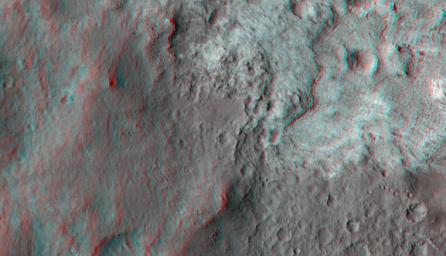
|
‘Glenelg’ in 3-D
- Click the image above for a larger view
- Full-Res JPEG (2414 x 1387) (554.1 kB)
- Full-Res TIFF (2414 x 1387) (10.1 MB)
Caption:
This 3D, or stereo anaglyph, view shows the upcoming science destination for NASA's Mars rover Curiosity, a region dubbed "Glenelg," where three different types of material seen from orbit come together (middle of picture). The view was produced from images taken by the High Resolution Imaging Science Experiment (HiRISE) on NASA's Mars Reconnaissance Orbiter as the satellite flew overhead on Aug. 12 and Sept. 8, 2012. The rover and its tracks can be seen at far left, from the latter (left-eye) image.
Viewing in 3D requires the traditional red-blue glasses, with red going over the left eye.
The image pairs have large stereo-convergence angles, which means that height differences in the terrain appear exaggerated; for example, the slopes look about ten times steeper than they really are. This exaggeration is useful over very flat terrain such as landing sites.
Background Info:
The full image set for these observations can be seen at: http://uahirise.org/releases/msl-3d.php .
HiRISE is one of six instruments on NASA's Mars Reconnaissance Orbiter. The University of Arizona, Tucson, operates the orbiter's HiRISE camera, which was built by Ball Aerospace & Technologies Corp., Boulder, Colo. NASA's Jet Propulsion Laboratory, a division of the California Institute of Technology in Pasadena, manages the Mars Reconnaissance Orbiter Project for NASA's Science Mission Directorate, Washington. Lockheed Martin Space Systems, Denver, built the spacecraft.
Cataloging Keywords:
| Name | Value | Additional Values |
|---|---|---|
| Target | Mars | |
| System | ||
| Target Type | Planet | |
| Mission | Mars Reconnaissance Orbiter (MRO) | Mars Science Laboratory (MSL) |
| Instrument Host | Mars Reconnaissance Orbiter | Curiosity Rover |
| Host Type | Orbiter | Rover |
| Instrument | High Resolution Imaging Science Experiment (HiRISE) | |
| Detector | ||
| Extra Keywords | Color | |
| Acquisition Date | ||
| Release Date | 2012-10-10 | |
| Date in Caption | ||
| Image Credit | NASA/JPL-Caltech/Univ. of Arizona | |
| Source | photojournal.jpl.nasa.gov/catalog/PIA16210 | |
| Identifier | PIA16210 | |
